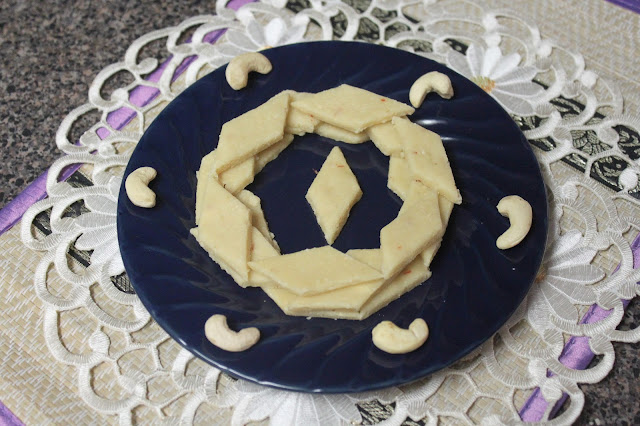Perhaps the mother of all Indian desserts, Kaju Katli is a universal favorite. The soft, buttery texture of the doughy-cashews, and the sweet scents of cardamom, saffron, and rosewater will tempt even the most disciplined sugar-opposers.
Making Kaju Katli is simple, in theory. However, in practice, I found most recipes to be missing some key links. I failed, failed, and failed some more in my attempts before I finally, finally, stumbled into this method, when I decided to experiment with the only fickle agents in this recipe - the consistency and heat applied to the sugar syrup. Meanwhile, my kitchen was filling up with more and more Kaju ladoos from all the failed experiments!
Here are the critical aspects that determine the success of this treat:
- The sugar syrup is the most important part of the recipe. If the sugar is over-boiled beyond the one-string consistency, the texture of the katli turns from fudge-like to candy-like. And once the sugar syrup reaches the one-string consistency, immediately remove from heat and do the rest of the steps without heat. Additional heat will turn the mixture to candy
- Knead, knead and knead the mixture to a smooth dough. Initially, it will seem almost hopeless to get to the smooth dough stage, but keep at it
- It's really really important to act fast! Act quick - especially while removing the sugar syrup from heat, and while kneading the mixture, rolling it out, and cutting the fudge.
In the end, if all else fails, make the ladoos!
Ingredients (makes a small batch):
- 1/2 cup sugar
- 1 cup cashews
- 1 teaspoon freshly powdered cardamom
- a pinch of saffron
- 2 teaspoons rose water
- a couple of teaspoons of ghee
- Powder/grind cashews by pulsing in a mixie/food processor. Take care to remove the powdered cashew before the oils release and the cashews turn greasy or into cashew butter!
- Grease a silicon baking mat, or a tray with some ghee
- In a non-stick or heavy bottomed saucepan, add sugar and a tablespoon of water. Start heating on medium heat and stir periodically until the sugar dissolves.
- Add cardamom and saffron and continue heating the sugar
- Keep stirring the sugar until the syrup reaches "one-string consistency" (see picture below). Keep checking the syrup periodically every minute, after the syrup begins to bubble/boil. Take a drop of the syrup, let it cool a couple seconds (literally) and then take it between your fingers and pull it out. If the syrup makes one unbroken string/strand, then the syrup is ready. The syrup will reach this stage in about 7-10 minutes. This is the most important step
- Immediately remove the pan from heat, and add rosewater and the powdered cashews to the syrup, and mix well. Initially, the heat from the syrup will make the powdered cashews loose and gloopy. Keep mixing, and in a few seconds, the mixture will form an uneven dough (check the pictures below)
- At this point, quickly transfer the dough to the greased baking mat / tray and with a fork (I used a fork because I found it too hot to use my hand), start kneading the dough to make it soft and pliable. Work quickly, and keep rolling/kneading/pressing/turning the dough until it becomes soft and even.
- Add more ghee if needed, then use your hand to additionally knead the dough until very pliable and smooth (this happens within a couple of minutes of kneading)
- Quickly, roll out the dough into desired thickness with a greased rolling pin
- With a greased knife / pizza cutter, score the rolled out dough into squares or diamonds. At this stage, if you like, decorate the scored fudge with edible silver foil and crumbled pistachios.
- When the dough has cooled a little, and the fudge is no longer too soft, separate the scored shapes
- Let the katlis come to room temperature, then serve
In my enthusiasm and anxiousness to work fast before the dough cooled, I ended up rolling out the dough into a thin sheet, so my katlis didn't have enough height/thickness to them. This technique worked as an effective portion-control strategy!




No comments:
Post a Comment
Thanks for leaving a comment! I appreciate it.
Note: Only a member of this blog may post a comment.